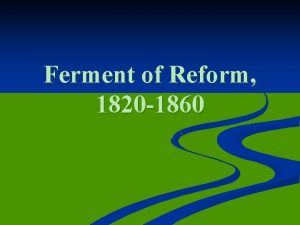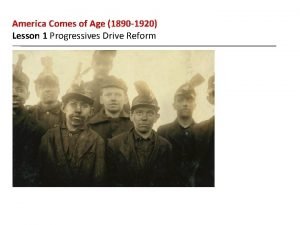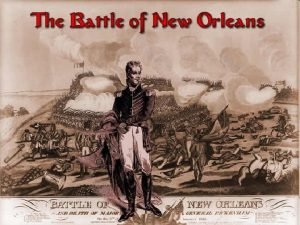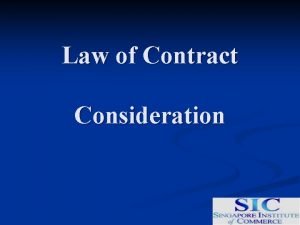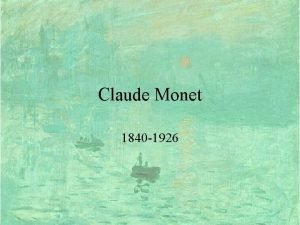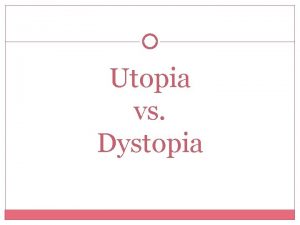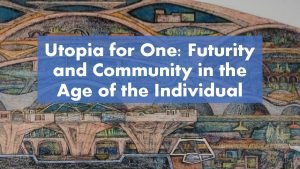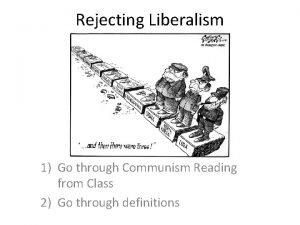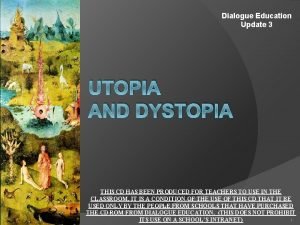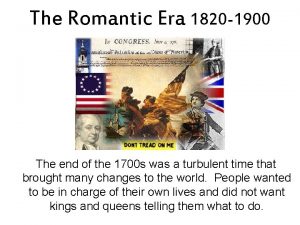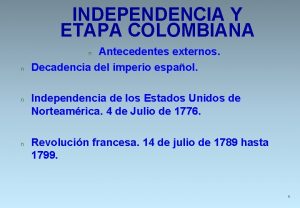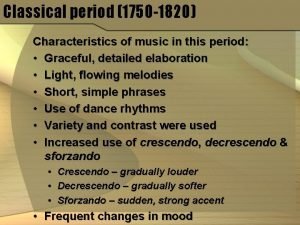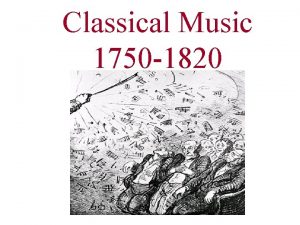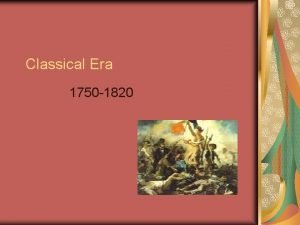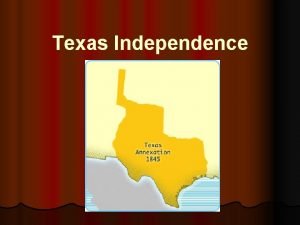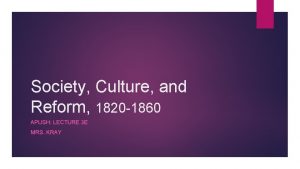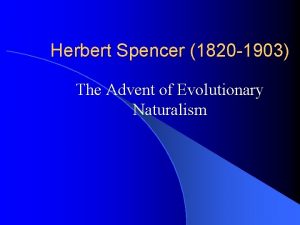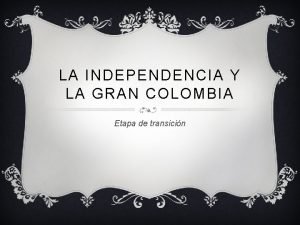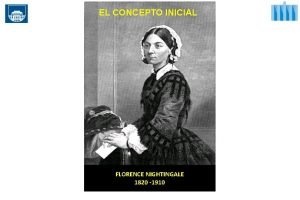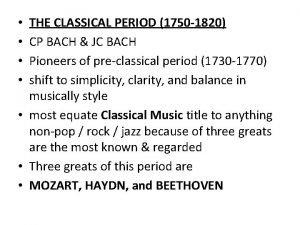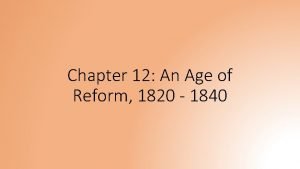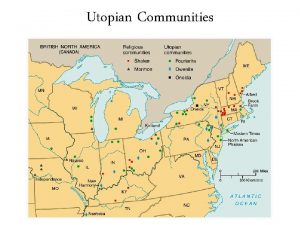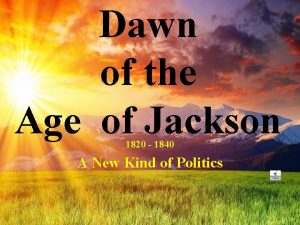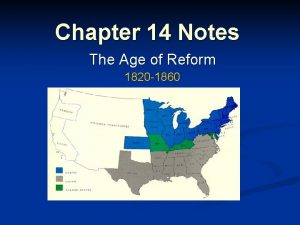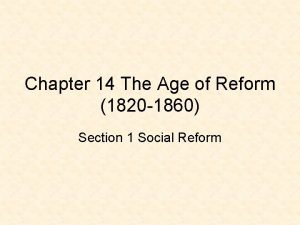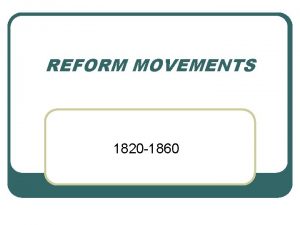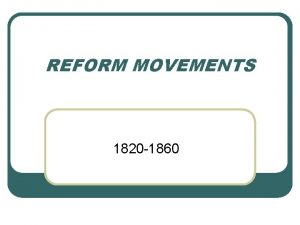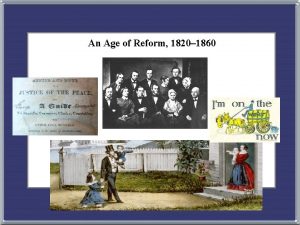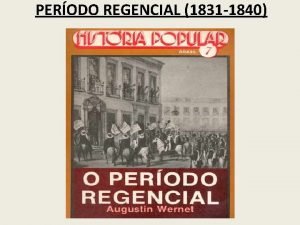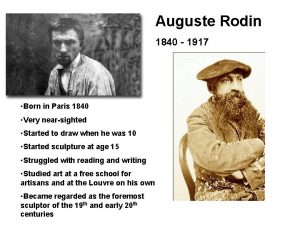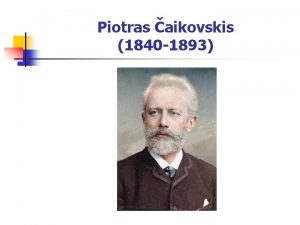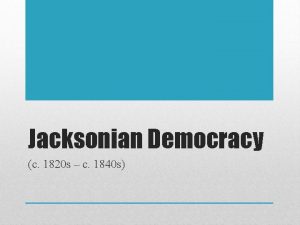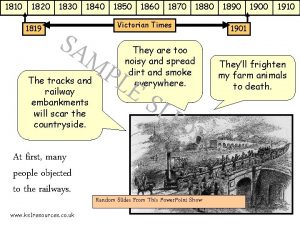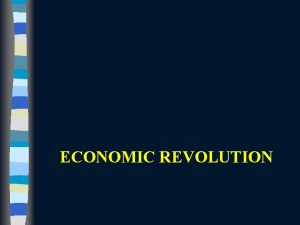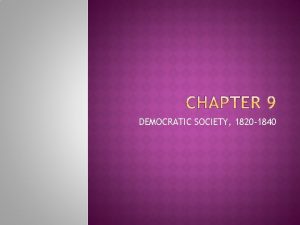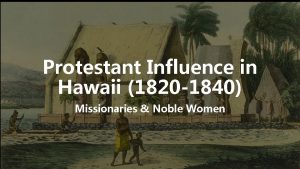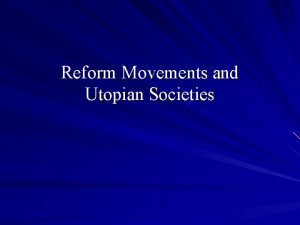Chapter 12 Age of Reform 1820 1840 UTOPIAN










































- Slides: 42

Chapter 12: Age of Reform, 1820 -1840 UTOPIAN COMMUNITIES PERFECTIONISM TEMPERANCE MOVEMENT COMMON SCHOOL AMERICAN COLONIZATION SOCIETY AMERICAN ANTI-SLAVERY SOCIETY MORAL SUASION UNCLE TOM’S CABIN “GENTLEMEN OF PROPERTY AND STANDING” GAG RULE DOROTHEA DIX WOMAN SUFFRAGE LIBERTY PARTY

The Reform Impulse

A. Utopian Communities �About 100 reform communities were established in the decades before the Civil War. �Nearly all the communities set out to reorganize society on a cooperative basis, hoping both to restore social harmony to a world of excessive individualism and also to narrow the widening gap between rich and poor. Socialism and communism entered the language.

Utopian Communities, Mid-Nineteenth Century

B. The Shakers �The Shakers were the most successful of the religious communities and had a significant impact on the outside world. �Shakers believed men and women were spiritually equal. �They abandoned private property and traditional family life.

C. The Mormons' Trek �The Mormons were founded in the 1820 s by Joseph Smith. �The absolute authority Smith exercised over his followers, the refusal of the Mormons to separate church and state, and their practice of polygamy alarmed many neighbors. �Mormons faced persecution in New York, Ohio, Missouri, and Illinois; Smith was murdered. �Smith's successor, Brigham Young, led his followers to the Great Salt Lake.

The Mormons

D. Oneida �The founder of Oneida, John Noyes, and his followers practiced "complex marriage. " �Oneida was an extremely dictatorial environment.

Oneida Community, 1907

E. Worldly Communities �The most important secular communitarian was Robert Owen. �Owen established New Harmony, where he hoped to create a "new moral world" �At New Harmony, Owen championed women's rights and education.

Robert Owen’s New Harmony (1838)

F. Religion and Reform �Some reform movements drew their inspiration from the religious revivalism of the Second Great Awakening. �The revivals popularized the outlook known as perfectionism, which saw both individuals and society at large as capable of indefinite improvement. �Under the impact of the revivals, older reform efforts moved in a new, radical direction. Prohibition, pacifism, and abolition �To members of the North's emerging middle-class culture, reform became a badge of respectability. �The American Temperance Society directed its efforts at both the drunkards and the occasional drinker.

American Temperance Society

G. Critics of Reform �Many Americans saw the reform impulse as an attack on their own freedom. Catholics rallied against the temperance movement. Archbishop of New York: “Man [is not an autonomous creature, but] by his nature, a being of society. ”


H. Reformers and Freedom �The vision of freedom expressed by the reform movements was liberating and controlling at the same time. �Many religious groups in the East formed reform groups promoting religious virtue.

American Tract Society

I. The Invention of the Asylum �Americans embarked on a program of institution building. Jails Poorhouses Asylums Orphanages �These institutions were inspired by the conviction that those who passed through their doors could eventually be released to become productive, selfdisciplined citizens.

J. The Common School �A tax-supported state public school system was widely adopted. �Horace Mann was the era's leading educational reformer. �Mann hoped that universal public education could restore equality to a fractured society. Avenue for social advancement �Common schools provided career opportunities for women but widened the divide between North and South.

Horace Mann

The Crusade Against Slavery

A. Colonization �The American Colonization Society (ACS), founded in 1816, promoted the gradual abolition of slavery and the settlement of black Americans in Africa. The ACS founded Liberia as its colony in West Africa. �Many prominent political leaders supported the ACS. �Like Indian removal, colonization rested on the premise that America is fundamentally a white society. �Most African-Americans adamantly opposed the idea of colonization. In 1817, free blacks assembled in Philadelphia for the first national black convention and condemned colonization. They insisted that blacks were Americans, entitled to the same rights enjoyed by whites.

American Colonization Project (Liberia)

B. Militant Abolitionism �A new generation of reformers demanded immediate abolition. �David Walker's An Appeal to the Coloured Citizens of the World was a passionate indictment of slavery and racial prejudice. �The appearance in 1831 of The Liberator, William Lloyd Garrison's weekly journal published in Boston, gave the new breed of abolitionism a permanent voice. �Some of Garrison's ideas appeared too radical, but his call for immediate abolition was echoed by many. Garrison rejected colonization.

C. Spreading the Abolitionist Message �Abolitionists recognized the democratic potential in the production of printed material. �Theodore Weld helped to create the abolitionists' mass constituency by using the methods of religious revivals. �Weld and a group of trained speakers spread the message of slavery as a sin.

D. Slavery and Moral Suasion �Nearly all abolitionists, despite their militant language, rejected violence as a means of ending slavery. �Many abolitionists were pacifists, and they attempted to convince the slaveholder through "moral suasion" of his sinful ways.

E. A New Vision of America �The antislavery movement sought to reinvigorate the idea of freedom as a truly universal entitlement. �They insisted that blacks were fellow countrymen, not foreigners or a permanently inferior caste. �Abolitionists disagreed over the usefulness of the Constitution. �Abolitionists consciously identified their movement with the revolutionary heritage. The Liberty Bell

ANGELINA GRIMKE, LETTER IN THE LIBERATOR (AUGUST 2, 1837) Transcript Since I engaged in the investigation of the rights of the slave, I have necessarily been led to a better understanding of my own; for I have found the Anti-Slavery cause to be. . . the school in which human rights are more fully investigated, and better understood and taught, than in any other [reform] enterprise. . Here we are led to examine why human beings have any rights. It is because they are moral beings. . Now it naturally occurred to me, that if rights were founded in moral being, then the circumstance of sex could not give to man higher rights and responsibilities, than to woman. . My doctrine, then is, that whatever it is morally right for man to do, it is morally right for woman to do. . This regulation of duty by the mere circumstance of sex. . . has led to all that [numerous] train of evils flowing out of the antichristian doctrine of masculine and feminine virtues. By this doctrine, man has been converted into the warrior, and clothed in sternness. . . whilst woman has been taught to lean upon an arm of flesh, to. . . be admired for her personal charms, and caressed and humored like a spoiled child, or converted into a mere drudge to suit the convenience of her lord and master. . It has robbed woman of. . . the right to think and speak and act on all great moral questions, just as men think and speak and act. . The discussion of the wrongs of slavery has opened the way for the discussion of other rights, and the ultimate result will most certainly be. . . the letting of the oppressed of every grade and description go free.

Black and White Abolitionism

A. Black Abolitionists � From its inception, blacks played a leading role in the antislavery movement. Frederick Douglass � Stowe's Uncle Tom's Cabin gave the abolitionist message a powerful human appeal as it was modeled on the autobiography of fugitive slave Josiah Henson. � By the 1840 s, black abolitionists sought an independent role within the movement, regularly holding their own conventions � At every opportunity, black abolitionists rejected the nation's pretensions as a land of liberty. � Black abolitionists articulated the ideal of color-blind citizenship. � Frederick Douglass famously questioned the meaning of the Fourth of July.

B. Gentlemen of Property and Standing �Abolitionism aroused violent hostility from northerners who feared that the movement threatened to disrupt the Union, interfere with profits wrested from slave labor, and overturn white supremacy. �Editor Elijah Lovejoy was killed by a mob while defending his press. �Mob attacks and attempts to limit abolitionists' freedom of speech convinced many northerners that slavery was incompatible with the democratic liberties of white Americans.

William Lloyd Garrison, Fredrick Douglas, Harriet Beecher Stowe

The Origins of Feminism

A. The Rise of the Public Woman �Women were instrumental in the abolition movement. �The public sphere was open to women in ways government and party politics were not.

B. Women and Free Speech �Women lectured in public about abolition. Grimké sisters �The Grimké sisters argued against the idea that taking part in assemblies, demonstrations, and lectures was unfeminine. �Letters on the Equality of the Sexes (1838) Equal pay for equal work

C. Women’s Rights �Elizabeth Cady Stanton and Lucretia Mott organized the Seneca Falls Convention of 1848. Raised the issue of woman suffrage �The Declaration of Sentiments condemned the entire structure of inequality.

D. Feminism and Freedom �Lacking broad backing at home, early feminists found allies abroad. �Women deserved the range of individual choices and the possibility of self-realization that constituted the essence of freedom. �Margaret Fuller sought to apply to women the transcendentalist idea that freedom meant a quest for personal development.

E. Women and Work �The participants at Seneca Falls rejected the identification of the home as the women's "sphere. " The "bloomer" costume

F. The Slavery of Sex �The concept of the "slavery of sex" empowered the women's movement to develop an all-encompassing critique of male authority and their own subordination. �Marriage and slavery became powerful rhetorical tools for feminists.

G. “Social Freedom” �The demand that women should enjoy the rights to regulate their own sexual activity and procreation and to be protected by the state against violence at the hands of their husbands challenged the notion that claims for justice, freedom, and individual rights should stop at the household's door. �The issue of women's private freedom revealed underlying differences within the movement for women's rights.

Sojourner Truth, Ain’t I A Woman (1851) "Well, children, where there is so much racket there must be something out of kilter. I think that 'twixt the negroes of the South and the women of the North, all talking about rights, the white men will be in a fix pretty soon. But what's all this here talking about? Then they talk about this thing in the head; what's this they call it? [Intellect, somebody whispers] That's it, honey. What's that got to do with women's rights or negro's rights? If my cup won't hold but a pint, and yours holds a quart, wouldn't you be mean not to let me have my little half measure-full? That man over there says that women need to be helped into carriages and lifted over ditches, and to have the best place everywhere. Nobody ever helps me into carriages, or over mud-puddles, or gives me any best place! And ain't I a woman? Look at me! Look at my arm! I could have ploughed and planted, and gathered into barns, and no man could head me! And ain't I a woman? I could work as much and eat as much as a man- when I could get it- and bear the lash as well! And ain't I a woman? I have borne thirteen children, and seen them most all sold off to slavery, and when I cried out with my mother's grief, none but Jesus heard me! And ain't I a woman? Then that little man in black there, he says women can't have as much rights as men, 'cause Christ wasn't a woman! Where did your Christ come from? From God and a woman! Man had nothing to do with Him. If the first woman God ever made was strong enough to turn the world upside down all alone, these women together ought to be able to turn it back, and get it right side up again! And now they is asking to do it, the men better let them. Obliged to you for hearing me, and now old Sojourner ain't got nothing more to say. "

H. The Abolitionist Schism �When organized abolitionism split into two wings in 1840, the immediate cause was a dispute over the proper role of women in antislavery work. American Anti-Slavery Society (favored women in leadership positions) American and Foreign Anti-Slavery Society (opposed women in leadership positions) �The Liberty Party was established in hopes of making abolitionism a political movement.
 Second great awakening
Second great awakening Stone age, bronze age iron age timeline
Stone age, bronze age iron age timeline Iron age bronze age stone age timeline
Iron age bronze age stone age timeline America comes of age lesson 1 progressives drive reform
America comes of age lesson 1 progressives drive reform We fired our guns and the british kept a comin
We fired our guns and the british kept a comin Segundo reinado 1840 a 1889
Segundo reinado 1840 a 1889 Bolton vs modden
Bolton vs modden Contoh stenotermal
Contoh stenotermal Segundo reinado 1840 a 1889
Segundo reinado 1840 a 1889 Fue descubierto y nombrado por schoenbein en 1840
Fue descubierto y nombrado por schoenbein en 1840 Claude monet 1840 1926
Claude monet 1840 1926 Dystopia simple definition
Dystopia simple definition Name date period
Name date period Data link layer design issues in computer networks
Data link layer design issues in computer networks Socialism examples
Socialism examples Utopia vs dystopia examples
Utopia vs dystopia examples Francis ford selffinance 120m utopian
Francis ford selffinance 120m utopian Utopian simplex protocol
Utopian simplex protocol Fahrenheit 451 discussion questions part 3
Fahrenheit 451 discussion questions part 3 Utopian novel definition
Utopian novel definition Communism
Communism Utopia vs dystopia
Utopia vs dystopia Characteristics of the romantic period
Characteristics of the romantic period 1820 hairstyles
1820 hairstyles It is an era from 1750-1820
It is an era from 1750-1820 Resumen de las revoluciones liberales
Resumen de las revoluciones liberales 1820-1900
1820-1900 Romantic era events
Romantic era events Less complicated texture than baroque (more homophonic)
Less complicated texture than baroque (more homophonic) Antecedentes externos
Antecedentes externos Revolucion liberal de 1820
Revolucion liberal de 1820 Franz joseph haydn characteristics of music
Franz joseph haydn characteristics of music 1820-1750
1820-1750 1820-1750
1820-1750 Ccc 1807
Ccc 1807 Moses austin
Moses austin Arthur and lewis tappan apush
Arthur and lewis tappan apush La traviata juomalaulu
La traviata juomalaulu Militarisml
Militarisml La campaña definitiva 1820 a 1822
La campaña definitiva 1820 a 1822 Florence nightingale, 1820–1910
Florence nightingale, 1820–1910 1820-1750
1820-1750 Simon bolivar y antonio jose de sucre
Simon bolivar y antonio jose de sucre
